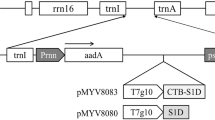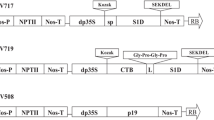Abstract
Actinobacillus pleuropneumoniae is a major etiological agent of swine pleuropneumonia, a highly contagious respiratory infection that causes severe economic losses in the swine production industry. ApxIIA, one of the virulence factors in A. pleuropneumoniae, is considered a candidate for the development of a vaccine against this bacterial infection. In this study, a fusion gene consisting of enterotoxigenic Escherichia coli heat-labile enterotoxin B subunit (LTB) and an ApxIIA fragment (amino acids 619–801) (ApxIIA619–801) was fused to the endoplasmic reticulum (ER) retention signal (SEKDEL) and introduced into a plant expression vector under the control of a ubiquitin promoter. The plant expression vector was transformed into tobacco Nicotiana tabacum L. cv. MD609 using an Agrobacterium-mediated transformation procedure. The integration and transcription of the LTB fusion gene were confirmed by genomic DNA PCR amplification and Northern blot analysis, respectively. The synthesis and assembly of LTB fusion protein were evidenced by Western blot analysis and the GM1-ganglioside enzyme-linked immunosorbent assay (GM1-ELISA). A quantitative ELISA used to measure the amount of LTB fusion protein produced in the transgenic plant revealed high levels of the fusion protein, up to 30 μg g−1, in lyophilized leaf tissue. These results demonstrate the feasibility of using a transgenic plant to express the LTB-ApxIIA619–801 fusion protein as a first step towards producing plant-based edible vaccines to elicit immune responses against A. pleuropneumoniae via an oral mucosal delivery system.




Similar content being viewed by others
References
Abul-Milh M, Paradis SE, Dubreuil JD, Jacques M (1999) Binding of Actinobacillus pleuropneumoniae lipopolysaccharides to glycosphingolipids evaluated by thin-layer chromatography. Infect Immun 67:4983–4987
Arakawa T, Yu J, Chong DK, Hough J, Engen PC, Langridge WH (1998) A plant-based cholera toxin B subunit-insulin fusion protein protects against the development of autoimmune diabetes. Nat Biotechnol 16:934–938
Bagdasarian MM, Nagai M, Frey J, Bagdasarian M (1999) Immunogenicity of Actinobacillus ApxIA toxin epitopes fused to the E. coli heat-labile enterotoxin B subunit. Vaccine 17:441–447
Blackall PJ, Klaasen HL, van den Bosch H, Kuhnert P, Frey J (2002) Proposal of a new serovar of Actinobacillus pleuropneumoniae: serovar 15. Vet Microbiol 84:47–52
Chiang CH, Huang WF, Huang LP, Lin SF, Yang WJ (2009) Immunogenicity and protective efficacy of ApxIA and ApxIIA DNA vaccine against Actinobacillus pleuropneumoniae lethal challenge in murine model. Vaccine 27:4565–4570
Dean C, Jones J, Favreau M, Dunsmuir P, Bedbrook J (1988) Influence of flanking sequences on variability in expression levels of an introduced gene in transgenic tobacco plants. Nucleic Acids Res 16:9267–9283
Desrosiers RC, Burghoff RL, Bakker A, Kamine J (1984) Construction of replication-competent Herpesvirus saimiri deletion mutants. J Virol 49:343–348
Dom P, Hommez J, Castryck F, Devriese LA, Haesebrouck F (1994) Serotyping and quantitative determination of in vitro antibiotic susceptibility of Actinobacillus pleuropneumoniae strains isolated in Belgium (July 1991–August 1992). Vet Q 16:10–13
Dubreuil JD, Jacques M, Mittal KR, Gottschalk M (2000) Actinobacillus pleuropneumoniae surface polysaccharides: their role in diagnosis and immunogenicity. Anim Health Res Rev 1:73–93
Frey J (1995) Virulence in Actinobacillus pleuropneumoniae and RTX toxins. Trends Microbiol 3:257–261
Fuller TE, Thacker BJ, Duran CO, Mulks MH (2000) A genetically-defined riboflavin auxotroph of Actinobacillus pleuropneumoniae as a live attenuated vaccine. Vaccine 18:2867–2877
Haesebrouck F, Chiers K, Van Overbeke I, Ducatelle R (1997) Actinobacillus pleuropneumoniae infections in pigs: the role of virulence factors in pathogenesis and protection. Vet Microbiol 58:239–249
Haesebrouck F, Pasmans F, Chiers K, Maes D, Ducatelle R, Decostere A (2004) Efficacy of vaccines against bacterial diseases in swine: what can we expect? Vet Microbiol 100:255–268
Jacques M, Belanger M, Roy G, Foiry B (1991) Adherence of Actinobacillus pleuropneumoniae to porcine tracheal epithelial cells and frozen lung sections. Vet Microbiol 27:133–143
Kang TJ, Yang MS (2004) Rapid and reliable extraction of genomic DNA from various wild-type and transgenic plants. BMC Biotechnol 4:20
Kang TJ, Loc NH, Jang MO, Jang YS, Kim YS, Seo JE, Yang MS (2003) Expression of the B subunit of E. coli heat-labile enterotoxin in the chloroplasts of plants and its characterization. Transgenic Res 12:683–691
Kang TJ, Han SC, Jang MO, Kang KH, Jang YS, Yang MS (2004) Enhanced expression of B-subunit of Escherichia coli heat-labile enterotoxin in tobacco by optimization of coding sequence. Appl Biochem Biotechnol 117:175–187
Kang TJ, Kim YS, Jang YS, Yang MS (2005) Expression of the synthetic neutralizing epitope gene of porcine epidemic diarrhea virus in tobacco plants without nicotine. Vaccine 23:2294–2297
Kang TJ, Han SC, Yang MS, Jang YS (2006) Expression of synthetic neutralizing epitope of porcine epidemic diarrhea virus fused with synthetic B subunit of Escherichia coli heat-labile enterotoxin in tobacco plants. Protein Express Purif 46:16–22
Kilian M, Mestecky J, Russell MW (1988) Defense mechanisms involving Fc-dependent functions of immunoglobulin A and their subversion by bacterial immunoglobulin A proteases. Microbiol Rev 52:296–303
Kim JM, Jung DI, Eom YJ, Park SM, Yoo HS, Jang YS, Yang MS, Kim DH (2010) Surface-displayed expression of a neutralizing epitope of ApxIIA exotoxin in Saccharomyces cerevisiae and oral administration of it for protective immune responses against challenge by Actinobacillus pleuropneumoniae. Biosci Biotechnol Biochem 74:1361–1367
Kozak M (1981) Possible role of flanking nucleotides in recognition of the AUG initiator codon by eukaryotic ribosomes. Nucleic Acids Res 9:5233–5252
Kunkel EJ, Butcher EC (2003) Plasma-cell homing. Nat Rev Immunol 3:822–829
Lee KY, Kim DH, Kang TJ, Kim J, Chung JH, Yoo HS, Arntzen CJ, Yang MS, Jang YS (2006) Induction of protective immune responses against the challenge of Actinobacillus pleuropneumoniae by the oral administration of transgenic tobacco plant expressing ApxIIA toxin from the bacteria. FEMS Immunol Med Microbiol 48:381–389
Liljeqvist S, Stahl S, Andreoni C, Binz H, Uhlen M, Murby M (1997) Fusions to the cholera toxin B subunit: influence on pentamerization and GM1 binding. J Immununol Methods 210:125–135
Loc NH, Song NV, Tien NQD, Minh TH, Nga PTQ, Kim TG, Yang MS (2010) Expression of the Escherichia coli heat-labile enterotoxin B subunit in transgenic watercress (Nasturtium officinale L.). Plant Cell Tiss Organ Cult. doi: 10.1007/s11240-010-9835-0
Ma JK, Drake PM, Christou P (2003) The production of recombinant pharmaceutical proteins in plants. Nat Rev Genet 4:794–805
Marillonnet S, Thoeringer C, Kandzia R, Klimyuk V, Gleba Y (2005) Systemic Agrobacterium tumefaciens-mediated transfection of viral replicons for efficient transient expression in plants. Nat Biotechnol 23:718–723
Millar DG, Hirst TR, Snider DP (2001) Escherichia coli heat-labile enterotoxin B subunit is a more potent mucosal adjuvant than its closely related homologue, the B subunit of cholera toxin. Infect Immun 69:3476–3482
Mitragotri S (2005) Immunization without needles. Nat Rev Immunol 5:905–916
Mora JR, Bono MR, Manjunath N, Weninger W, Cavanagh LL, Rosemblatt M, Von Andrian UH (2003) Selective imprinting of gut-homing T cells by Peyer’s patch dendritic cells. Nature 424:88–93
Murashige T, Skoog F (1962) A revised medium for rapid growth and bioassay with tobacco tissue cultures. Physiol Plant 15:473–497
Neutra MR, Kozlowski PA (2006) Mucosal vaccines: the promise and the challenge. Nat Rev Immunol 6:148–158
Park SM, Choi EJ, Kwon TH, Jang YS, Yoo HS, Choi W, Park BK, Kim DH (2005) Expression of the Apx toxins of Actinobacillus pleuropneumoniae in Saccharomyces cerevisiae and its induction of immune response in mice. Biotechnol Bioprocess Eng 10:362–366
Peach C, Velten J (1991) Transgene expression variability position effect of CAT and GUS reporter genes driven by linked divergent T-DNA promoters. Plant Mol Biol 17:49–60
Pilette C, Ouadrhiri Y, Godding V, Vaerman JP, Sibille Y (2001) Lung mucosal immunity: immunoglobulin-A revisited. Eur Respir J 18:571–588
Prideaux CT, Lenghaus C, Krywult J, Hodgson AL (1999) Vaccination and protection of pigs against pleuropneumonia with a vaccine strain of Actinobacillus pleuropneumoniae produced by site-specific mutagenesis of the ApxII operon. Infect Immun 67:1962–1966
Ramjeet M, Deslandes V, Goure J, Jacques M (2008) Actinobacillus pleuropneumoniae vaccines: from bacterins to new insights into vaccination strategies. Anim Health Res Rev 9:25–45
Reimer D, Frey J, Jansen R, Veit HP, Inzana TJ (1995) Molecular investigation of the role of ApxI and ApxII in the virulence of Actinobacillus pleuropneumoniae serotype 5. Microb Pathog 18:197–209
Rybicki EP (2009) Plant-produced vaccines: promise and reality. Drug Discov Today 14:16–24
Shin SJ, Bae JL, Cho YW, Lee DY, Kim DH, Yang MS, Jang YS, Yoo HS (2005) Induction of antigen-specific immune responses by oral vaccination with Saccharomyces cerevisiae expressing Actinobacillus pleuropneumoniae ApxIIA. FEMS Immunol Med Microbiol 43:155–164
Snider DP (1995) The mucosal adjuvant activities of ADP-ribosylating bacterial enterotoxins. Crit Rev Immunol 15:317–348
Tascón RI, Vazquez-Boland JA, Gutierrez-Martin CB, Rodriguez-Barbosa I, Rodriguez-Ferri EF (1994) The RTX haemolysins ApxI and ApxII are major virulence factors of the swine pathogen Actinobacillus pleuropneumoniae: evidence from mutational analysis. Mol Microbiol 14:207–216
Tremblay R, Wang D, Jevnikar AM, Ma S (2010) Tobacco, a highly efficient green bioreactor for production of therapeutic proteins. Biotechnol Adv 28:214–221
Van Haute E, Joos H, Maes M, Warren G, Van Montagu M, Schell J (1983) Intergeneric transfer and exchange recombination of restriction fragments cloned in pBR322: a novel strategy for the reversed genetics of the Ti plasmids of Agrobacterium tumefaciens. EMBO J 2:411–417
Woof JM, Kerr MA (2006) The function of immunoglobulin A in immunity. J Pathol 208:270–282
Acknowledgments
This study was supported by a grant from Biogreen 21 Program (20080401034048), RDA, Republic of Korea.
Author information
Authors and Affiliations
Corresponding author
Rights and permissions
About this article
Cite this article
Kim, MY., Kim, TG., Yoo, HS. et al. Expression and assembly of ApxIIA toxin of Actinobacillus pleuropneumoniae fused with the enterotoxigenic E. coli heat-labile toxin B subunit in transgenic tobacco. Plant Cell Tiss Organ Cult 105, 375–382 (2011). https://doi.org/10.1007/s11240-010-9877-3
Received:
Accepted:
Published:
Issue Date:
DOI: https://doi.org/10.1007/s11240-010-9877-3




